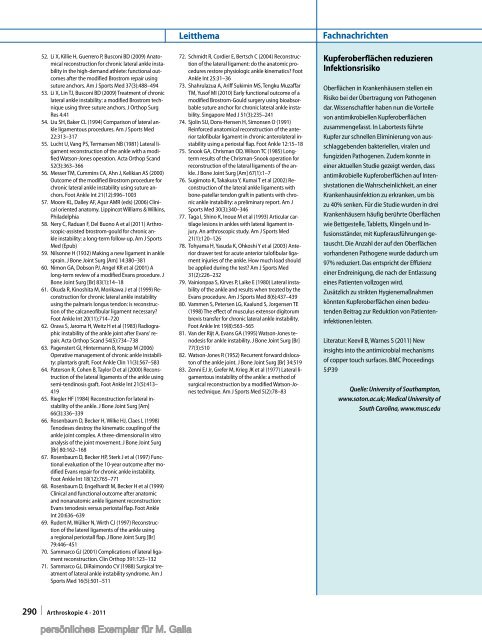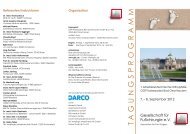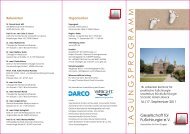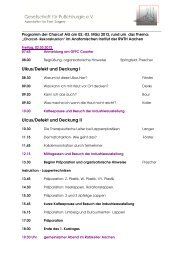Arthroskopische laterale OSG-Stabilisierung in modifizierter ...
Arthroskopische laterale OSG-Stabilisierung in modifizierter ...
Arthroskopische laterale OSG-Stabilisierung in modifizierter ...
Sie wollen auch ein ePaper? Erhöhen Sie die Reichweite Ihrer Titel.
YUMPU macht aus Druck-PDFs automatisch weboptimierte ePaper, die Google liebt.
52. Li X, Killie H, Guerrero P, Busconi BD (2009) Anatomical<br />
reconstruction for chronic lateral ankle <strong>in</strong>stability<br />
<strong>in</strong> the high-demand athlete: functional outcomes<br />
after the modified Brostrom repair us<strong>in</strong>g<br />
suture anchors. Am J Sports Med 37(3):488–494<br />
53. Li X, L<strong>in</strong> TJ, Busconi BD (2009) Treatment of chronic<br />
lateral ankle <strong>in</strong>stability: a modified Brostrom technique<br />
us<strong>in</strong>g three suture anchors. J Orthop Surg<br />
Res 4:41<br />
54. Liu SH, Baker CL (1994) Comparison of lateral ankle<br />
ligamentous procedures. Am J Sports Med<br />
22:313–317<br />
55. Lucht U, Vang PS, Termansen NB (1981) Lateral ligament<br />
reconstruction of the ankle with a modified<br />
Watson-Jones operation. Acta Orthop Scand<br />
52(3):363–366<br />
56. Messer TM, Cumm<strong>in</strong>s CA, Ahn J, Kelikian AS (2000)<br />
Outcome of the modified Brostrom procedure for<br />
chronic lateral ankle <strong>in</strong>stability us<strong>in</strong>g suture anchors.<br />
Foot Ankle Int 21(12):996–1003<br />
57. Moore KL, Dalley AF, Agur AMR (eds) (2006) Cl<strong>in</strong>ical<br />
oriented anatomy. Lipp<strong>in</strong>cot Williams & Wilk<strong>in</strong>s,<br />
Philadelphia<br />
58. Nery C, Raduan F, Del Buono A et al (2011) Arthroscopic-assisted<br />
brostrom-gould for chronic ankle<br />
<strong>in</strong>stability: a long-term follow-up. Am J Sports<br />
Med (Epub)<br />
59. Nilsonne H (1932) Mak<strong>in</strong>g a new ligament <strong>in</strong> ankle<br />
spra<strong>in</strong>. J Bone Jo<strong>in</strong>t Surg [Am] 14:380–381<br />
60. Nimon GA, Dobson PJ, Angel KR et al (2001) A<br />
long-term review of a modified Evans procedure. J<br />
Bone Jo<strong>in</strong>t Surg [Br] 83(1):14–18<br />
61. Okuda R, K<strong>in</strong>oshita M, Morikawa J et al (1999) Reconstruction<br />
for chronic lateral ankle <strong>in</strong>stability<br />
us<strong>in</strong>g the palmaris longus tendon: is reconstruction<br />
of the calcaneofibular ligament necessary?<br />
Foot Ankle Int 20(11):714–720<br />
62. Orava S, Jaroma H, Weitz H et al (1983) Radiographic<br />
<strong>in</strong>stability of the ankle jo<strong>in</strong>t after Evans‘ repair.<br />
Acta Orthop Scand 54(5):734–738<br />
63. Pagenstert GI, H<strong>in</strong>termann B, Knupp M (2006)<br />
Operative management of chronic ankle <strong>in</strong>stability:<br />
plantaris graft. Foot Ankle Cl<strong>in</strong> 11(3):567–583<br />
64. Paterson R, Cohen B, Taylor D et al (2000) Reconstruction<br />
of the lateral ligaments of the ankle us<strong>in</strong>g<br />
semi-tend<strong>in</strong>osis graft. Foot Ankle Int 21(5):413–<br />
419<br />
65. Riegler HF (1984) Reconstruction for lateral <strong>in</strong>stability<br />
of the ankle. J Bone Jo<strong>in</strong>t Surg [Am]<br />
66(3):336–339<br />
66. Rosenbaum D, Becker H, Wilke HJ, Claes L (1998)<br />
Tenodeses destroy the k<strong>in</strong>ematic coupl<strong>in</strong>g of the<br />
ankle jo<strong>in</strong>t complex. A three-dimensional <strong>in</strong> vitro<br />
analysis of the jo<strong>in</strong>t movement. J Bone Jo<strong>in</strong>t Surg<br />
[Br] 80:162–168<br />
67. Rosenbaum D, Becker HP, Sterk J et al (1997) Functional<br />
evaluation of the 10-year outcome after modified<br />
Evans repair for chronic ankle <strong>in</strong>stability.<br />
Foot Ankle Int 18(12):765–771<br />
68. Rosenbaum D, Engelhardt M, Becker H et al (1999)<br />
Cl<strong>in</strong>ical and functional outcome after anatomic<br />
and nonanatomic ankle ligament reconstruction:<br />
Evans tenodesis versus periostal flap. Foot Ankle<br />
Int 20:636–639<br />
69. Rudert M, Wülker N, Wirth CJ (1997) Reconstruction<br />
of the laterel ligaments of the ankle us<strong>in</strong>g<br />
a regional periostall flap. J Bone Jo<strong>in</strong>t Surg [Br]<br />
79:446–451<br />
70. Sammarco GJ (2001) Complications of lateral ligament<br />
reconstruction. Cl<strong>in</strong> Orthop 391:123–132<br />
71. Sammarco GJ, DiRaimondo CV (1988) Surgical treatment<br />
of lateral ankle <strong>in</strong>stability syndrome. Am J<br />
Sports Med 16(5):501–511<br />
290 | Arthroskopie 4 · 2011<br />
Leitthema<br />
72. Schmidt R, Cordier E, Bertsch C (2004) Reconstruction<br />
of the lateral ligament: do the anatomic procedures<br />
restore physiologic ankle k<strong>in</strong>ematics? Foot<br />
Ankle Int 25:31–36<br />
73. Shahrulazua A, Ariff Sukim<strong>in</strong> MS, Tengku Muzaffar<br />
TM, Yusof MI (2010) Early functional outcome of a<br />
modified Brostrom-Gould surgery us<strong>in</strong>g bioabsorbable<br />
suture anchor for chronic lateral ankle <strong>in</strong>stability.<br />
S<strong>in</strong>gapore Med J 51(3):235–241<br />
74. Sjol<strong>in</strong> SU, Dons-Hensen H, Simonsen O (1991)<br />
Re<strong>in</strong>forced anatomical reconstruction of the anterior<br />
talofibular ligament <strong>in</strong> chronic anterolateral <strong>in</strong>stability<br />
us<strong>in</strong>g a periostal flap. Foot Ankle 12:15–18<br />
75. Snook GA, Chrisman OD, Wilson TC (1985) Longterm<br />
results of the Chrisman-Snook operation for<br />
reconstruction of the lateral ligaments of the ankle.<br />
J Bone Jo<strong>in</strong>t Surg [Am] 67(1):1–7<br />
76. Sugimoto K, Takakura Y, Kumai T et al (2002) Reconstruction<br />
of the lateral ankle ligaments with<br />
bone-patellar tendon graft <strong>in</strong> patients with chronic<br />
ankle <strong>in</strong>stability: a prelim<strong>in</strong>ary report. Am J<br />
Sports Med 30(3):340–346<br />
77. Taga I, Sh<strong>in</strong>o K, Inoue M et al (1993) Articular cartilage<br />
lesions <strong>in</strong> ankles with lateral ligament <strong>in</strong>jury.<br />
An arthroscopic study. Am J Sports Med<br />
21(1):120–126<br />
78. Tohyama H, Yasuda K, Ohkoshi Y et al (2003) Anterior<br />
drawer test for acute anterior talofibular ligament<br />
<strong>in</strong>juries of the ankle. How much load should<br />
be applied dur<strong>in</strong>g the test? Am J Sports Med<br />
31(2):226–232<br />
79. Va<strong>in</strong>ionpaa S, Kirves P, Laike E (1980) Lateral <strong>in</strong>stability<br />
of the ankle and results when treated by the<br />
Evans procedure. Am J Sports Med 8(6):437–439<br />
80. Vammen S, Petersen LG, Kaalund S, Jorgensen TE<br />
(1998) The effect of musculus extensor digitorum<br />
brevis transfer for chronic lateral ankle <strong>in</strong>stability.<br />
Foot Ankle Int 19(8):563–565<br />
81. Van der Rijt A, Evans GA (1995) Watson-Jones tenodesis<br />
for ankle <strong>in</strong>stability. J Bone Jo<strong>in</strong>t Surg [Br]<br />
77(3):510<br />
82. Watson-Jones R (1952) Recurrent forward dislocaton<br />
of the ankle jo<strong>in</strong>t. J Bone Jo<strong>in</strong>t Surg [Br] 34:519<br />
83. Zenni EJ Jr, Grefer M, Krieg JK et al (1977) Lateral ligamentous<br />
<strong>in</strong>stability of the ankle: a method of<br />
surgical reconstruction by a modified Watson-Jones<br />
technique. Am J Sports Med 5(2):78–83<br />
Fachnachrichten<br />
Kupferoberflächen reduzieren<br />
Infektionsrisiko<br />
Oberflächen <strong>in</strong> Krankenhäusern stellen e<strong>in</strong><br />
Risiko bei der Übertragung von Pathogenen<br />
dar. Wissenschaftler haben nun die Vorteile<br />
von antimikrobiellen Kupferoberflächen<br />
zusammengefasst. In Labortests führte<br />
Kupfer zur schnellen Elim<strong>in</strong>ierung von ausschlaggebenden<br />
bakteriellen, viralen und<br />
fungiziden Pathogenen. Zudem konnte <strong>in</strong><br />
e<strong>in</strong>er aktuellen Studie gezeigt werden, dass<br />
antimikrobielle Kupferoberflächen auf Intensivstationen<br />
die Wahrsche<strong>in</strong>lichkeit, an e<strong>in</strong>er<br />
Krankenhaus<strong>in</strong>fektion zu erkranken, um bis<br />
zu 40% senken. Für die Studie wurden <strong>in</strong> drei<br />
Krankenhäusern häufig berührte Oberflächen<br />
wie Bettgestelle, Tabletts, Kl<strong>in</strong>geln und Infusionsständer,<br />
mit Kupferausführungen getauscht.<br />
Die Anzahl der auf den Oberflächen<br />
vorhandenen Pathogene wurde dadurch um<br />
97% reduziert. Das entspricht der Effizienz<br />
e<strong>in</strong>er Endre<strong>in</strong>igung, die nach der Entlassung<br />
e<strong>in</strong>es Patienten vollzogen wird.<br />
Zusätzlich zu strikten Hygienemaßnahmen<br />
könnten Kupferoberflächen e<strong>in</strong>en bedeutenden<br />
Beitrag zur Reduktion von Patienten<strong>in</strong>fektionen<br />
leisten.<br />
Literatur: Keevil B, Warnes S (2011) New<br />
<strong>in</strong>sights <strong>in</strong>to the antimicrobial mechanisms<br />
of copper touch surfaces. BMC Proceed<strong>in</strong>gs<br />
5:P39<br />
Quelle: University of Southampton,<br />
www.soton.ac.uk; Medical University of<br />
South Carol<strong>in</strong>a, www.musc.edu






